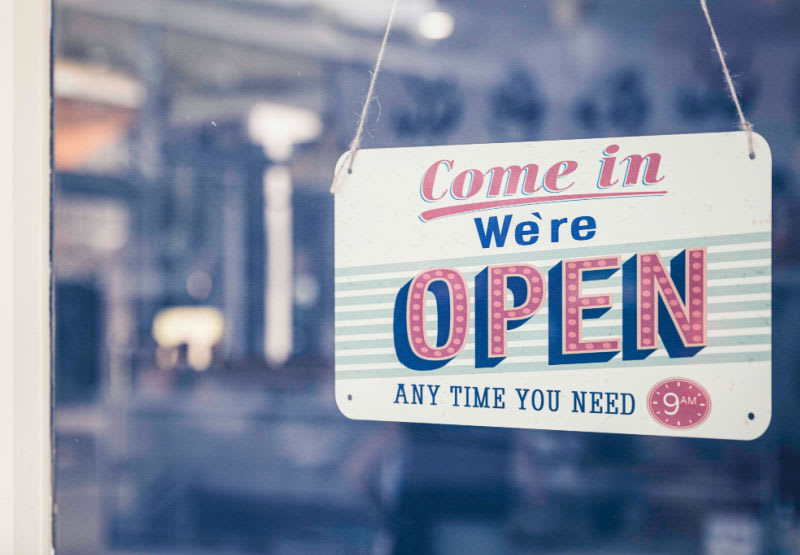18 Restaurant Marketing Ideas for 2024 (How to Market a Restaurant?)
We’ve rounded up the top 18 ways restaurants can market their businesses, including both online and offline methods, to help you boost your chances of success.
 November 19, 2023
November 19, 2023 13 minute reading
13 minute reading
We’ve rounded up the top 18 ways restaurants can market their businesses, including both online and offline methods, to help you boost your chances of success in the restaurant industry.
For any restaurant, digital marketing is a key part of success. Good marketing means that people know about your business, what kind of food you serve, and where exactly they can find your restaurant.
When it comes to choosing a marketing strategy for your restaurant, however, it might seem like an impossible task trying to figure out which methods would be best suited to your needs, as well as your budget.
Thankfully, we’ve rounded up the top 18 ways restaurants can market their businesses, including both online and offline methods, to help you thrive in the restaurant business.
Here are 18 restaurant marketing strategies to try in 2023:
1. Establish your restaurant's brand, brand voice, and tone of voice
Your restaurant's brand, brand voice, and tone of voice are different things. Your brand is how your customers perceive You, whereas your brand voice represents what you stand for—your values, mission, vision, and perspectives. And, your tone of voice is how you speak to your customers.
A restaurant marketing strategy should have a clear definition of these elements, as they will help you create an effective restaurant marketing plan that aligns with your goals and can be executed easily.
An effective marketing strategy should also define who your ideal customers are using buyer personas. Do they live in a certain neighborhood? Are they affluent? Do they have kids? What are their food-related spending habits? Once you know who these people are, it'll be easier for you to reach them with the right message at the right time and through the right marketing channels.
Brand Voice & Tone
2. Make a website for your restaurant
Having a website for your restaurant is an absolute must. It’s the first place people will go to find information about your restaurant, and it’s also the first thing potential customers will see when they search for you online.
Your restaurant website should have clear calls to action (CTAs), such as “get directions,” “find out our hours,” and “make a reservation.” If you don’t yet have a website, hire a professional web designer who can design one in line with your brand identity, so it looks appealing to both current customers and new ones alike.
Create a stunning website for your restaurant
The content on your website must also be engaging and easy to read. It should tell the story of your restaurant, offer information about what you serve (and how), and answer any questions diners might have before they visit. Additionally, it should feature an easily accessible menu and showcase high-quality photos of your restaurant and its workers, as well as any imagery from events your business has hosted in the past.
To create content of the highest quality, consider outsourcing this task to a professional web content writer.
Additionally, your website needs to be easy to navigate. Make sure that every page is clearly labeled and easy to find, as well as mobile-friendly so that people can easily access your site from any device.
3. Utilize local SEO
When you optimize your website and marketing materials for local search engines, it can help bring new clients from around your area who are searching for restaurants near them.
Local SEO tactics include:
a. Optimizing your website with local keywords
This makes sure that people who are looking for a local restaurant will be able to find yours through their search results. If you have a physical address on your website, make sure that it's prominent and easy to find.
Prior knowledge of local SEO is important if you want to succeed in this area. Therefore, it's helpful to hire the services of a freelance local SEO expert to help you get started.
b. Establish your Google Business Profile account for your restaurant

Google Business Profile (formerly known as Google My Business) is a free service that empowers local businesses to control their online presence across Google's platforms, such as Search and Maps. A restaurant owner can create a listing on Google Maps and add photos, videos, specials, and more to help users learn about the business before they visit in person.
A Google Business Profile account is crucial for any local business looking to gain high exposure on Google search results since users are constantly searching for local services such as nearby restaurants, cafes and bars.
According to a study conducted by backlinko in 2020, 42% of local searches end up withs user clicking on local pack results.
Google Business Profile also provides special features for restaurants such as menu display and an online reservation call to action (GBP does not provide the technology for online ordering, only a visible link for whatever tool your business is using)
Stand out on Google for local searches with the help of freelance SEO experts
c. For restaurants with multiple branches
Make sure you create a page for each branch and share unique information about same branch such as:
Opening hours
Address
Contact details, such as phone number, email address, social media handles, etc.
Images of interior and staff
Menu
Events
Link to reservation / order
Anything else you think you can tell about that branch

Need some inspiration? Check out Hard rock cafe's local pages
Also, you can add buttons on these website pages to contact you through calls, SMS, email, social media platforms, and messaging apps to enhance customer experience.
Need some inspiration? Check out Hard rock cafe's local pages.
4. Add your restaurant to online directories
Online directories are another excellent way for diners in your location to discover your restaurant. There are a number of key online directories you should consider adding your restaurant to, including:
Yelp: Yelp is an online directory for local businesses that's been around since 2004. It allows you to add your restaurant, share photos and reviews from customers, connect with other business owners, and send messages.
TripAdvisor: TripAdvisor is a review site where travelers can find information about hotels and restaurants in their area or on their next trip. You'll need to create an account before you can submit a listing request form, and it will ask for basic information about your restaurant (name and address), as well as some marketing details (hours of operation).
OpenTable: OpenTable is another review site where diners can leave feedback about their experience at various restaurants around the country. If they're members of OpenTable's loyalty program (which comes with benefits like free reservations), they may be able to earn points toward discounts off future meals at participating establishments.
Yahoo Local: Yahoo Local also offers business listings across hundreds of categories including dining establishments, making it another online directory worth pursuing.
5. Create a social media presence for your restaurant
A social media presence is a great way to encourage people to engage with your restaurant on a more personal level. Facebook, Twitter, Instagram, and other platforms are perfect for broadcasting news events such as new menu items or special deals to followers. You can also use these platforms to showcase photos of your food and the restaurant itself.
Social media is also a great tool for collecting user-generated content like online reviews. Encourage guests who have enjoyed their time at your restaurant to leave social media reviews about their dining experience in exchange for a free meal or discount on their next meal. You can even include social media contests or giveaways in your social media marketing plan.
You should also be sure to engage with your audience via these platforms. Respond to their comments and questions, and thank them for their feedback. You should also address their negative reviews, apologize for the bad experiences, give an explanation if you have one, and assure them to take appropriate action to correct the mistake. This will help you build trust and loyalty with your customers.
Creating and managing these social media profiles can be time-consuming, however, which is why many restaurant owners choose to outsource this task to a freelance social media expert.
Work with freelancers to professionally manage your social media pages
6. Work with influencers such as food bloggers and social media influencers
Food influencers are social media users with a large following who regularly post about food. If you have a restaurant, these can be helpful in spreading the word about your business. Social media influencers will create content on their own social media platforms and share it with their followers, while paid food bloggers can write positive reviews of your restaurant on their own websites, describing it as one of the best restaurants in that specific locality.
TikTok is a particularly effective platform for restaurants to embrace in their influencer marketing efforts. This is because 36% of TikTok users have gone to a restaurant or ordered food from it after seeing it on the platform.
Videos with the hashtag #TikTokFood, for example, have currently received over 79 billion views, and the app is also renowned for sparking viral food crazes. A three-ingredient Oreo cake has attracted over 42.1 million views alone. Poppy O’Toole, Tabitha Brown, and Gianluca Conte are just three of many rising stars specializing in food vlogging on the platform.
Food bloggers and social media influencers can also be helpful in driving people to your website. This is especially true if they include a link to your site in their posts. This will also increase the number of clicks that come from these sources, and thus boost your search engine optimization (SEO).
7. Start a blog and write about relevant topics
You can also create a blog and write about topics related to food, cooking, or your restaurant. You can even reveal interesting information about your restaurant’s food and recipes while including food photos or any special ingredients or methods used in each dish.
Anyone who has a website can create a blog on it. The advantage of having your own blog is that you can control what’s published on it, when it’s posted, and how often. It also gives you a great channel for communicating with your target audience in a more in-depth way.
If you don't have any prior experience in content writing, you can outsource this task to a professional writer instead.
8. Use paid advertising on Google or social platforms
Paid advertising is another great way to promote your restaurant online if you have a decent marketing budget. It can help new restaurants get immediate visibility to local diners, helping them boost their brand awareness and get new diners. The main paid advertising methods are Google Ads, as well as social media advertising, such as through Facebook Ads and Instagram Ads.
These platforms allow you to target people based on their location, age, and interests. For example, if your restaurant is an Italian bistro serving homemade pasta and wine, you can target potential customers who have searched for “Italian restaurants near me" or "best pasta" in the last day or week.
The more specific you are with your targeting, the better. If you want to reach people who live nearby, you can also target a radius around your restaurant’s location using these platforms.
9. Send out email newsletters with special offers and discounts
Email marketing is a great way to share news of upcoming events and special offers, or even to use as the primary channel for communicating with your audience.
You can also use your email list to send updates on new menu items, or even to send out a “thank you” note after a customer has dined at your establishment. By doing this, you help build customer loyalty and increase the likelihood of them coming back.
If you run a restaurant with a large database of customer information, you may want to consider offering discounts via email marketing campaigns on certain days or during certain times of the day (e.g., late night happy hour) to boost your customers during slower periods.
10. Utilize video marketing for your restaurant
When you're trying to attract new customers, video marketing is a great way to showcase your dishes and introduce them to potential diners. You could post videos of the preparation process, for example, as well as taste tests of various dishes.
You can also make short clips of yourself or your staff preparing or serving food. These videos should be brief (up to a few minutes long) and they should focus on one particular aspect of the restaurant at a time. For example, if you're known for having a great wine selection, post a video that shows off your extensive list or offers tips on pairing wines with specific dishes.
The more professional your videos are, the more engaging they will be. Therefore, consider hiring the services of a video editing expert to help you out.
Create stunning video ads and commercials
11. Invest in a proper online menu for your restaurant
An online menu is one of the first things people will look for when they find your website or even just search for your restaurant.
The menu should be clearly laid out and easy to read. You also want to make sure it’s mobile-friendly so that people can easily view it on their mobile devices or tablets when they are on the go.
You should also include some photos of the food. This will help people decide what they want to order before they come in or even when they are on the way there.
Having an online menu also allows you to easily add new items, update prices, and remove things as needed to ensure your restaurant’s information remains up to date.
12. Partner up with restaurant delivery services
Partnering with restaurant delivery services can be a great way to expand your reach and make online ordering more convenient for customers who live within your area. Restaurant delivery services allow customers to get your food delivered straight to their doorstep. These apps have already got the infrastructure set up, so all you need to do is take advantage of it!
Restaurant delivery services are also a great way for customers who can't dine in. They'll be able to customize their orders using the website or app, then pick them up or have them delivered when they're ready.
Depending on the service, you may also be able to offer discounts and promotions to customers who order through them. This is a great way to increase sales while providing convenience for your customers.
13. Create a loyalty card that rewards customers
You can create a loyalty program that rewards loyal customers for completing a certain number of visits, such as three in a row or five in one month. This type of reward scheme is especially effective if you offer discounts or freebies to repeat customers, who are already loyal to your brand.
Another way you can use loyalty programs is by rewarding customers who refer friends, family members, and co-workers. This helps to build word-of-mouth advertising for your business, while also encouraging new visitors to come and try out your restaurant.
Additionally, you could award points based on a diner’s total amount of dollars spent at the end of each month. These points could then be converted into cash off their next order or even gift cards redeemable at other non-competing stores, such as Amazon.
14. Hold special events and promotions for your restaurant
Special events and promotions, such as trivia nights, wine tastings, happy hours, or an evening featuring live music or karaoke are great ways to increase awareness of your business while also getting customers into the habit of coming in more often.
To promote these events:
Post about the event on social media a few weeks in advance, with a reminder at least one day before the event.
Make sure you have enough staff on hand to handle the increase in diners.
Promote the event before it starts by handing out flyers in your local area. You may even want to offer discounted drinks or appetizers once people are already seated for breakfast or lunch, as this will give them some incentive for returning to the event later once things get busy again.
15. Offer discounts for large groups or parties
Your restaurant should consider offering a discount for large groups of diners, such as 10 or more. This is especially important if you have other offers that make the restaurant less expensive for larger parties. For example, if you offer a free appetizer with every group meal with over 10 people, then offering additional discounts will encourage customers to book large parties at your establishment.
You can also incentivize guests to host their parties at your restaurant by offering special discounts on food and drinks during these events. For example, if someone is hosting an 18th birthday party at their house but wants it catered for with food from your restaurant, you can seal the deal by giving them 15% off their entire order.
16. Place flyers and posters advertising your restaurant in other local businesses and schools
You can also market your restaurant by placing posters and flyers in local businesses. These are more likely to be seen by customers who frequent those establishments, and they may even post them on their bulletin boards or social media pages.
In addition, you can also advertise your restaurant in local schools. Students (and their families) who attend school there might choose to eat at your restaurant because they have seen the flyer or poster advertising it.
Bundle Up Your Flyers & Invitations
17. Give out free things to potential restaurant customers
You can give out coupons to potential diners who walk past your restaurant. Offer a free appetizer or dessert coupon and encourage them to come back with their friends or family. You can also offer a discounted meal for the next time they visit.
Additionally, people love receiving free samples—especially when it comes to food. This allows potential diners to be able to try some delicious samples of your menu favorites before committing to dining in. It will also encourage them to order the full-sized versions of anything that impressed them.
18. Have your restaurant sponsor local events or charities
You can also consider sponsoring local events or a specific charity throughout the year by donating a certain percentage of your restaurant’s sales. This is a great way to make sure that people are familiar with your business and its food, but also boosts your reputation by allowing you to give back to the local community.
Of course, this is something that would require some careful planning, as you'll want to make sure that the organization you choose aligns with both who you are as a restaurant (e.g., family-owned) and what kind of reputation (e.g., health-conscious) fits best with how people think about your brand.
As an added benefit, you'll likely get some good press by being associated with a local event or charity. It's also a great way to get your name out there, as people who attend these events are likely to talk about them to their network and recommend that others attend as well.
Start your restaurant marketing strategy today
Whether you choose all or some of the marketing ideas from this guide, the key to a successful restaurant marketing strategy for your restaurant is for it to be as comprehensive as possible. This involves using a combination of both offline and online marketing methods to increase your reach and boost your restaurant's customer base.
Remember, if you need assistance with any of these marketing strategies, help is on-hand. Fiverr is home to thousands of freelance marketing experts who can take the hassle out of marketing your restaurant and boost your chances of success.



